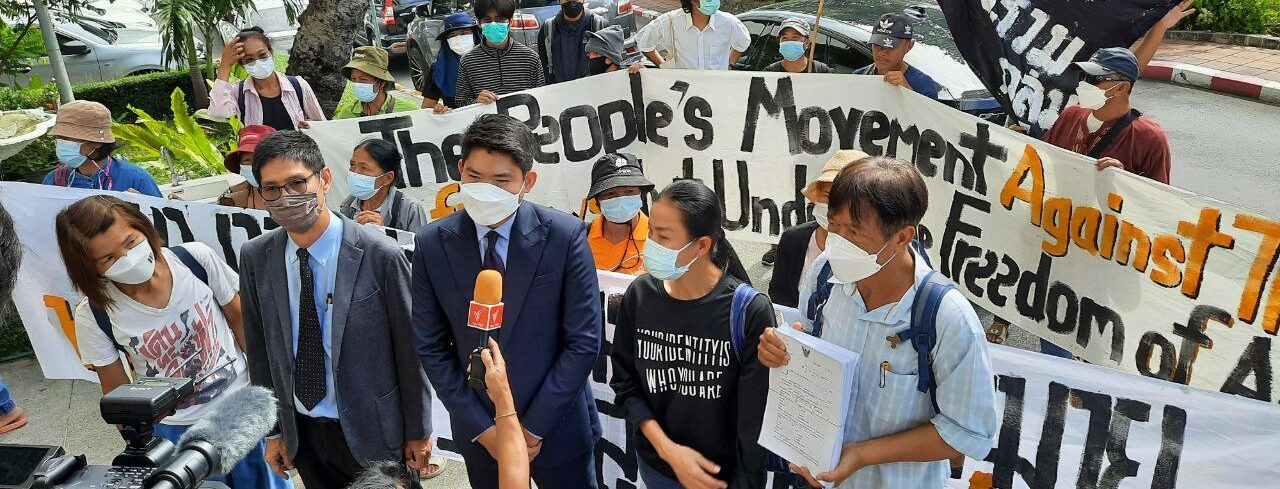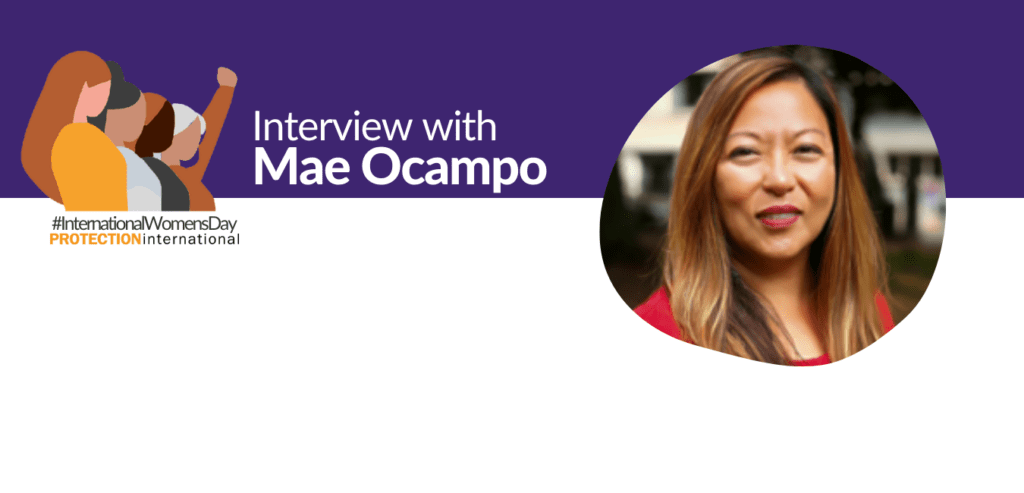International Women’s Day
In November 2021, we asked some of the women human rights defenders working for Protection International (PI) about their experiences, passions, and visions for a better future. Now, to mark International Women’s Day (8 March) and to celebrate the extraordinary work of women we translated our interviews with these women human rights defenders into French and Spanish.What was it that set you on the path to becoming a human rights defender?
I’m a martial law baby (this is what we call Filipinas/os who were born during the time of the dictatorship). I am a Filipina daughter who lived through the Marcos dictatorship when corruption and extra-judicial killings were the ‘norm’. I was raised in Angeles City, Pampanga in barangay Cutcut which was very near the (former) United States military base called US Clark Air Base, the largest installation outside the United States (US).
I became an activist and human rights defender at a very young age, around 14 years old, due to the context we lived in. The combination of being a martial law baby with the presence of the US military bases in my city and the local realities we faced, awakened me to injustices and atrocities my people suffered and propelled me to learn and act. Where there are US military bases, there is poverty, land grabbing, prostitution, corruption, etc. And of course….there are also resistance movements, youth movements, and human rights defenders.
I became part of the youth movement and was actively engaged in fighting against imperialism, feudalism, and bureaucrat capitalism. I was active in defending the rights of the Aeta Indigenous people (the first known settlers in our province) whose lands were grabbed or privatized to be sold or rented out to the US military. The Aetas were displaced and pushed further away from their lands, settling in very harsh conditions in the mountains. Some even became homeless. I remember seeing them begging on the streets, and I remember the anger I felt about the injustice they suffered. The corrupt dictatorship abandoned its people in favor of the imperialist US. I also remember how angry I felt seeing how many Filipina women who were exposed to vulnerable situations and were poverty stricken had to sell their bodies to earn a living….many of whom were violated, raped, abused….and even left for dead with no justice accorded to them – because US soldiers and military personnel had complete immunity.
I felt the fire and the call in my blood to be part of a movement to defend the rights of my people. This started my path as a youth leader and human rights defender. I learned about the plight of our people and the drivers of human rights violations at a very young age. I took part in sit-ins, political discussions, demonstrations, etc. I led the first strike in my high school to fight for student’s rights and fought to have a Magna Carta for student rights. I led mass walk-outs calling for a successful end to power politics, suppression of girls’ rights, and the fascist military training in our school, and I successfully organized the first school-wide boycott to fight against tuition fee increases. I became actively involved with the young feminist movement and the environmental justice movement which initiated my work with Friends of the Earth Philippines and later on for almost 20 years, Friends of the Earth International. The rest is history… I’m very passionate about human rights and I continue to defend our rights as an intrinsic and fundamental part of my life.
Are there other women human rights defenders (WHRDs) that continue to inspire you?
Yes, many. Especially from other student leaders and from the organization I belonged to since 1987 called Samahan ng mga Dalagang Pilipina (which translates to “movement of young women”). I was also very much inspired by my Asian tiger mama (cliché but true) who instilled in me to get up whenever I fell, continue to learn, and be a leader.
I’ll forever be inspired by the fierce Filipina feminists and WHRDs I looked up to in my years as a young activist, such as Maria Lorena Barros – my forever she-ro – our resister who fought against the Marcos dictatorship and established the strongest national women’s movement. And, of course, in my formational years, I listened to stories of women resisters and fearless warriors who bravely fought in arms against the many colonialists and oppressors such as Gabriela Silang, Gregoria de Jesus, and Kumander Liwayway – I aspired to be like them! And of course, Filipina women who helped shape Philippine feminism in recent decades: Karina Constantino-David, Sister Mary John Mananzan, Sylvia “Guy” Claudio, Judy Taguiwalo, etc.
I’ll be remiss if I don’t mention the many feminists I look up to: Ruth Bader Ginsburg, Simone de Beauvoir, Audrey Lorde, Emmeline Pankhurst, Sojourner Truth, Rosa Luxemburg, Gloria Steinem, Tarana Burke, Angela Davis, Claudia Jones, etc.
There are also our recently fallen she-roes who died fighting: Berta Cáceres (Honduran land/Indigenous rights leader), Gloria Capitan (Filipina land rights leader), Orouba Barakat (Syrian activist), Marielle Franco (Brazilian black activist and councilwoman), Maria da Lurdes Fernandes Silva (Brazilian land rights leader), and many many more…
Are there sufficient protections and mechanisms of support for women human rights defenders in your home country?
The Republic of the Philippines is a “democratic” country and since the dictatorship was toppled, many laws (Republic Acts) that protect the rights of women were passed. There is also a Bill on human rights defenders that was recently passed which encompasses WHRDs in some sense and is used as a basis to protect WHRDs. The problem complies with these laws, the political will of the current government, and the overall lack of recognition for women’s and girls’ rights. Given the Philippines’ patriarchal history, a deeply rooted and ingrained Catholic faith, and the unjust systemic issues that the current government perpetuates, WHRDs are often subjected to violence, torture, rape, and extra-judicial killings or are labeled as terrorists. It’s one thing to have laws and mechanisms to protect WHRDs and another thing to implement them. In the Philippine context, there needs to be a structural and systemic change. I, together with many Filipinos hope that we can achieve this in the upcoming national elections come 9 May 2022.
In your opinion, what have been the most important cultural changes concerning gender equality and women’s rights that you’ve seen take place during your lifetime?
Women in leadership and women in politics. Since the toppling of the Marcos dictatorship, the Philippines has had two Filipina women elected as Presidents. The first woman elected was the wife of the assassinated hero Ninoy Aquino – his death led to the Philippine revolution in the 1980s that toppled the Marcos dictatorship. The Filipino people elected Cory Aquino into power, who was seen as the uniting force at that time. Having a first woman President did not mean that women’s rights were immediately recognized or that gender equality happened, but it was certainly the pivoting moment that helped shift conversations in the Philippines and challenged cultural limitations and religious beliefs. All of a sudden, a woman was “capable” of leading a country and not only confined at home. With this, there was an increase in political dialogues and conversations about gender equality women’s rights, and women in leadership in various sectors.
There’s still a lot to do, especially concerning early education about gender equality, power relations, sex education, etc.
How does being a woman manifest itself in your daily human rights protection work?
As a woman, my vision is to live in a just and sustainable world. A world free from oppression and patriarchal systems. This guides me in everything I do, and I always strive to be a feminist leader embracing my principles and values. This influences my way of working, leading, and being, where I strive for self-awareness, self-care care for others, and the assurance that we put people at the core of our work. I want to make sure that I check my biases and dismantle unconscious biases. I want to cultivate intersectional and inclusive ways of working by sharing power and adopting a transparent use of authority and power. I strive to always honor, respect and give recognition. As a woman of color, I want to make sure that I am portraying that I am comfortable in my skin. No matter how informal I can be – since I continue to nurture the ‘child’ and joy in me – I am secure in my ways and therefore, hope to remind and inspire others to do so too. This also includes side-lining any judgments when mistakes arise, embracing humility, and continuing to learn.
I recognize my power as an Asian woman and celebrate how far I’ve come especially in light of the many years I had to fight my way through predominantly male-dominated and white-dominated spaces. And because of my struggles as a woman of color – I hope to inspire other young women of color to take spaces of leadership as well. My context has made me sensitive to other people’s contexts and struggles. This is what feminist leadership is all about.
What advice do you have for young women who are witnessing injustices?
In very short concise simple terms – take your space, speak up, and act. In case of insecurity and fear for one’s life – contact the nearest HRD organization to assist you. Silence is no longer an option.
Looking forward, what gives you hope?
The amazing fire and energy of girls and young women around the world who are taking their space, embodying leadership, and speaking out in the streets. These young women are not afraid, and they are affecting political conversations that need to happen. I am inspired and hopeful that the work that we, from the older generations, have been doing will not be wasted. I look forward to the future women leaders who will make a difference, especially in national and international decision-making spaces.
I am, of course, looking forward and inspired that our movement building, which was in the past mostly national or regional, has gone global. This is thanks to modern technology that enabled us to connect in ways that were not possible before.
Protection International’s role, now more than ever, is more salient across the globe not only because we are delivering on our mandate to protect WHRDs but more importantly because we are part of the process in ensuring that the agency of women is understood and recognized across the world.


